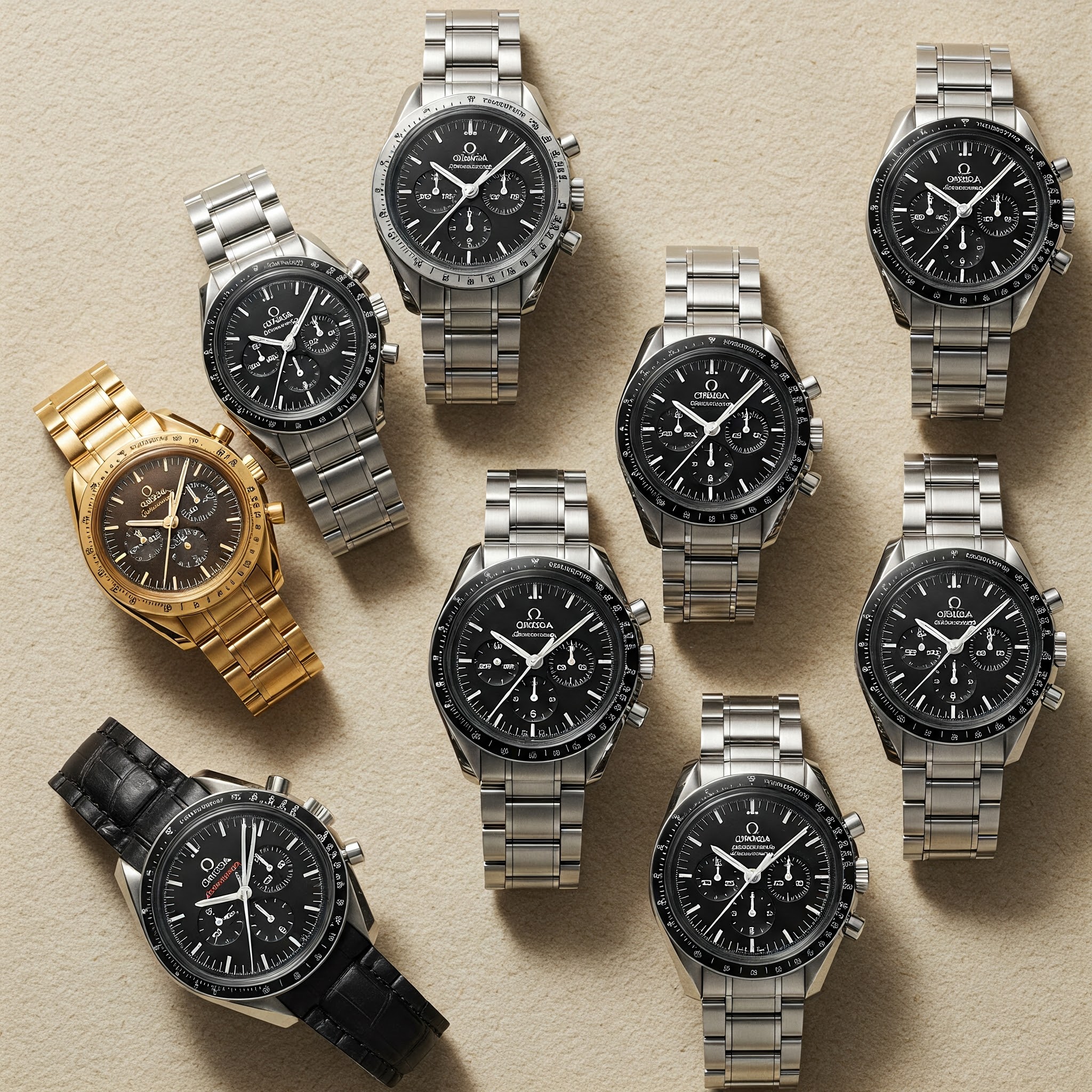In the vast universe of horology, few timepieces command the same reverence and instant recognition as the Omega Speedmaster. It’s a watch that transcends mere timekeeping; it’s a historical artifact, a marvel of engineering, and a symbol of human ambition. Nicknamed the “Moonwatch” for its pivotal role in space exploration, the Speedmaster’s appeal stretches far beyond the cosmos, rooted in a rich history, robust design, and unwavering performance. But what exactly makes this chronograph such an enduring icon, beloved by collectors, enthusiasts, and adventurers alike? Let’s delve into the history, features, and design philosophy that cemented the Speedmaster’s legendary status.
Genesis of Speed: Design by Claude Baillod
The Speedmaster story begins not in space, but on the racetrack. Launched in 1957, it was part of Omega’s “Professional” trilogy, alongside the Seamaster 300 and the Railmaster. Each was designed for specific professional fields: diving, science/engineering, and, in the Speedmaster’s case, motorsport and athletics. The objective was clear: create a highly legible, robust, and precise chronograph capable of timing events accurately.
The visionary behind the Speedmaster’s iconic look was a young Omega designer named Claude Baillod. His design brief resulted in several groundbreaking features. Most notably, the Speedmaster was the first chronograph wristwatch to feature its tachymeter scale not on the dial, but on the bezel. This simple yet revolutionary move significantly enhanced legibility, allowing drivers or technicians to read elapsed time and calculate speed without the scale cluttering the main dial. Baillod’s initial design (reference CK2915) featured a high-contrast black dial with luminous white hands and indices (including the distinctive “Broad Arrow” hour hand on early models), ensuring readability under varying conditions. The sturdy stainless steel case housed the legendary Calibre 321 movement, a sophisticated column-wheel chronograph developed with Lemania, known for its reliability and precision. It was a tool watch, built for purpose, yet possessed an undeniable aesthetic appeal.
The Rigorous Path to Space Qualification
While initially aimed at the world of speed on Earth, the Speedmaster’s destiny lay amongst the stars. In the early 1960s, NASA began searching for a wristwatch durable enough to withstand the extreme conditions of space travel for its Gemini and Apollo missions. Flight Crew Operations Director Deke Slayton issued an internal memo outlining the need for a reliable chronograph. NASA’s engineers anonymously procured several chronographs from different manufacturers – including Rolex, Longines-Wittnauer, Hamilton, and Omega – through Corrigan’s, a Houston retailer.
These watches were then subjected to a battery of brutal tests, designed to simulate the harshest environments imaginable:
- High and low temperature extremes (-18°C to +93°C)
- Temperature-pressure cycling (low pressure followed by high temperature)
- Relative humidity tests
- Oxygen atmosphere exposure
- Shock tests (multiple 40g impacts)
- Acceleration tests
- Decompression to near vacuum
- High pressure tests
- Vibration tests
- Acoustic noise tests
Only one watch survived this horological torture chamber: the Omega Speedmaster (by then the reference ST105.003, the model tested). In March 1965, NASA declared the Speedmaster “Flight Qualified for all Manned Space Missions.” It became standard issue for astronauts, not as a luxury item, but as a critical piece of mission equipment.
The Moonwatch Legacy: From Apollo 11 to Apollo 13
The Speedmaster’s most famous chapter began on July 21st, 1969. While Neil Armstrong took humanity’s first steps on the lunar surface, he had left his Speedmaster inside the Lunar Module (LEM) as a backup for the malfunctioning onboard timer. Therefore, it was Buzz Aldrin’s Omega Speedmaster Professional (ref. ST105.012) that became the first watch worn on the Moon, strapped securely around the outside of his bulky spacesuit. This singular event cemented the “Moonwatch” moniker and propelled the Speedmaster into the annals of history.
However, its role extended beyond simply being present. During the perilous Apollo 13 mission in 1970, an oxygen tank explosion crippled the spacecraft, forcing the crew to shut down most electronic systems to conserve power, including their digital timers. When performing a critical 14-second course correction burn using the Lunar Module’s descent engine – essential for ensuring a safe trajectory back to Earth – astronaut Jack Swigert timed the burn using his NASA-issued Omega Speedmaster. The watch performed flawlessly under immense pressure, playing a vital role in the crew’s safe return. In recognition of this contribution, Omega was awarded NASA’s prestigious “Silver Snoopy Award” later that year.
Defining Features and Evolution
Over its decades-long production run, the Speedmaster has seen various iterations, yet its core DNA remains remarkably consistent. Key features define the classic “Moonwatch”:
- The Chronograph Function: Three sub-dials typically display running seconds, a 30-minute counter, and a 12-hour counter, operated by the two pushers flanking the crown.
- Tachymeter Bezel: Used to measure speed over a known distance or distance based on speed. Its external placement remains a signature design element.
- Movement: The original Calibre 321 is highly sought after by vintage collectors. It was replaced in 1968 by the equally robust, though slightly simpler (cam-actuated vs. column-wheel), Calibre 861. This movement, and its rhodium-plated successor the Calibre 1861, powered the Moonwatch for decades. Modern iterations feature the Calibre 3861, a METAS-certified Master Chronometer with Co-Axial escapement, offering superior anti-magnetism and precision.
- Case Design: Early models had straight lugs and symmetrical cases. From 1964 (ref. ST105.012), the case became asymmetrical, with lyre lugs and guards protecting the crown and pushers – a design feature born from NASA’s requirements.
- Crystal: Traditionally, the Moonwatch used Hesalite (acrylic) crystal. This was preferred by NASA as it doesn’t shatter into tiny fragments like sapphire, making it safer in zero gravity. Hesalite offers a warmer look but scratches more easily (though scratches can often be buffed out). Omega also offers versions with sapphire crystal (front and often display back) for enhanced scratch resistance.
- Dial Legibility: The high-contrast black dial with white hands and markers ensures excellent readability, a core requirement from its inception.
Why the Enduring Popularity?
The Omega Speedmaster’s sustained success stems from a unique confluence of factors:
- Unparalleled History: The verifiable connection to the Apollo program and the Moon landing gives it a historical significance unmatched by almost any other watch. It’s a tangible link to one of humanity’s greatest achievements.
- Timeless Design: Claude Baillod’s original design was functional, legible, and aesthetically balanced. Its tool-watch origins give it a purposeful look that has remained relevant for over 65 years.
- Proven Reliability: Its survival through NASA’s brutal testing and flawless performance during critical space missions speaks volumes about its robustness and mechanical integrity.
- Versatility: While born as a professional tool, the Speedmaster cleans up remarkably well. It looks equally at home with a spacesuit, a racing suit, or a business suit.
- Brand Heritage: Omega is a respected brand with a long history of innovation and quality watchmaking.
- Strong Community & Variations: A passionate collector community exists worldwide. Omega has also cleverly expanded the line with numerous variations (different sizes, materials like ceramic or gold, automatic movements, special editions) while maintaining the core Professional Moonwatch, ensuring there’s a Speedmaster for almost every taste.
An Icon Forged in Time and Space
The Omega Speedmaster is far more than just a watch; it’s a legend. From its functional roots on the racetrack, designed with clarity and purpose by Claude Baillod, to its incredible journey to the lunar surface and its critical role in space exploration history, the Speedmaster has earned its iconic status. Its enduring appeal lies in this rich narrative, combined with a timeless design, robust engineering, and the proven reliability of its beating heart. Whether cherished as a vintage collectible, worn as a daily reminder of human potential, or admired for its technical prowess, the Omega Speedmaster continues to captivate and inspire, a true chronograph king whose legacy is etched not just in time, but across the stars.




